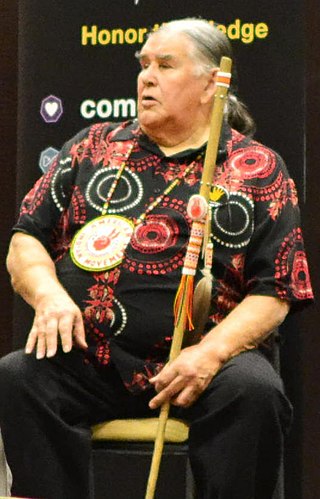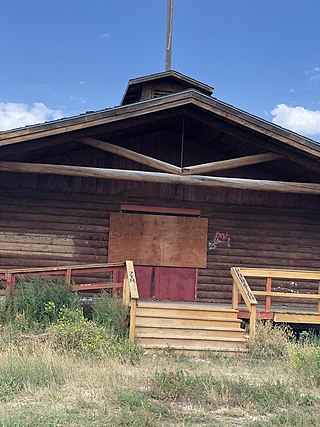Related Research Articles

The Lakota are a Native American people. Also known as the Teton Sioux, they are one of the three prominent subcultures of the Sioux people, with the Eastern Dakota (Santee) and Western Dakota (Wičhíyena). Their current lands are in North and South Dakota. They speak Lakȟótiyapi—the Lakota language, the westernmost of three closely related languages that belong to the Siouan language family.

The American Indian Movement (AIM) is an American Indian grassroots movement which was founded in Minneapolis, Minnesota in July 1968, initially centered in urban areas in order to address systemic issues of poverty, discrimination, and police brutality against American Indians. AIM soon widened its focus from urban issues to many Indigenous Tribal issues that American Indian groups have faced due to settler colonialism in the Americas. These issues have included treaty rights, high rates of unemployment, the lack of American Indian subjects in education, and the preservation of Indigenous cultures.

Tribal sovereignty in the United States is the concept of the inherent authority of Indigenous tribes to govern themselves within the borders of the United States.

The Bureau of Indian Affairs (BIA), also known as Indian Affairs (IA), is a United States federal agency within the Department of the Interior. It is responsible for implementing federal laws and policies related to Native Americans and Alaska Natives, and administering and managing over 55,700,000 acres (225,000 km2) of reservations held in trust by the U.S. federal government for indigenous tribes. It renders services to roughly 2 million indigenous Americans across 574 federally recognized tribes. The BIA is governed by a director and overseen by the Assistant Secretary for Indian Affairs, who answers to the Secretary of the Interior.

An American Indian reservation is an area of land held and governed by a U.S. federal government-recognized Native American tribal nation, whose government is autonomous, subject to regulations passed by the United States Congress and administered by the United States Bureau of Indian Affairs, and not to the U.S. state government in which it is located. Some of the country's 574 federally recognized tribes govern more than one of the 326 Indian reservations in the United States, while some share reservations, and others have no reservation at all. Historical piecemeal land allocations under the Dawes Act facilitated sales to non–Native Americans, resulting in some reservations becoming severely fragmented, with pieces of tribal and privately held land being treated as separate enclaves. This jumble of private and public real estate creates significant administrative, political, and legal difficulties.

Dennis Banks was a Native American activist, teacher, and author. He was a longtime leader of the American Indian Movement, which he co-founded in Minneapolis, Minnesota in 1968 to represent urban Indians. He was a pre-eminent spokesman for Native Americans. His protests won government concessions and created national attention and sympathy for the oppression and deplorable endemic social and economic conditions for Native Americans.

Clyde Howard Bellecourt was a Native American civil rights organizer. His Ojibwe name is Nee-gon-we-way-we-dun, which means "Thunder Before the Storm". He founded the American Indian Movement (AIM) in Minneapolis, Minnesota, in 1968 with Dennis Banks, Eddie Benton-Banai, and George Mitchell. His elder brother, Vernon Bellecourt, was also active in the movement.

In the United States, an American Indian tribe, Native American tribe, Alaska Native village, Indigenous tribe or Tribal nation may be any current or historical tribe, band, nation, or community of Native Americans in the United States. Modern forms of these entities are often associated with land or territory of an Indian reservation. "Federally recognized Indian tribe" is a legal term in United States law with a specific meaning.

The Wounded Knee Occupation, also known as Second Wounded Knee, began on February 27, 1973, when approximately 200 Oglala Lakota and followers of the American Indian Movement (AIM) seized and occupied the town of Wounded Knee, South Dakota, United States, on the Pine Ridge Indian Reservation. The protest followed the failure of an effort of the Oglala Sioux Civil Rights Organization (OSCRO) to use impeachment to remove tribal president Richard Wilson, whom they accused of corruption and abuse of opponents. Additionally, protesters criticized the United States government's failure to fulfill treaties with Native American people and demanded the reopening of treaty negotiations to hopefully arrive at fair and equitable treatment of Native Americans.

The Red Power movement was a social movement led by Native American youth to demand self-determination for Native Americans in the United States. Organizations that were part of the Red Power Movement include the American Indian Movement (AIM) and the National Indian Youth Council (NIYC). This movement sought the rights for Native Americans to make policies and programs for themselves while maintaining and controlling their own land and resources. The Red Power movement took a confrontational and civil disobedience approach to inciting change in United States to Native American affairs compared to using negotiations and settlements, which national Native American groups such as National Congress of American Indians had before. Red Power centered around mass action, militant action, and unified action.
The Bureau of Indian Affairs building takeover refers to a protest by Native Americans at the Department of the Interior headquarters in the United States capital of Washington, D.C., from November 3 to November 9, 1972. On November 3, a group of around 500 American Indians with the American Indian Movement (AIM) took over the Interior building in Washington, D.C. It being the culmination of their cross-country journey in the Trail of Broken Treaties, intended to bring attention to American Indian issues such as living standards and treaty rights.

The National Congress of American Indians (NCAI) is an American Indian and Alaska Native rights organization. It was founded in 1944 to represent the tribes and resist U.S. federal government pressure for termination of tribal rights and assimilation of their people. These were in contradiction of their treaty rights and status as sovereign entities. The organization continues to be an association of federally recognized and state-recognized Indian tribes.
Native American self-determination refers to the social movements, legislation and beliefs by which the Native American tribes in the United States exercise self-governance and decision-making on issues that affect their own people.

The Indian Self-Determination and Education Assistance Act of 1975 authorized the Secretary of the Interior, the Secretary of Health, Education, and Welfare, and some other government agencies to enter into contracts with, and make grants directly to, federally recognized Indian tribes. The tribes would have authority for how they administered the funds, which gave them greater control over their welfare. The ISDEAA is codified at Title 25, United States Code, beginning at section 5301.
Henry Lyle Adams was an American Native rights activist known as a successful strategist, tactician, and negotiator. He was instrumental in resolving several key conflicts between Native Americans and state and federal government officials after 1960. Born on a reservation in Montana and based in Washington state for much of his life, he participated in protests and negotiations in Washington, DC and Wounded Knee, South Dakota.
Pan-Indianism is a philosophical and political approach promoting unity, and to some extent cultural homogenization, among different Indigenous groups in the Americas regardless of tribal distinctions and cultural differences.

The National Indian Youth Council (NIYC) is the second oldest American Indian organization in the United States with a membership of more than 15,000. It was the second independent native student organization, and one of the first native organizations to use direct action protests as a means to pursue its goals. During the 1960s, NIYC acted primarily as a civil rights organization. It was very active in the movement to preserve tribal fishing rights in the Northwest.
The following outline is provided as an overview of and topical guide to United States federal Indian law and policy:
Carter Camp was an American Indian Movement activist. Camp played a leading role in the 1972 Trail of Broken Treaties that traveled to Washington, DC, where protesters took over the Department of Interior building. Camp was also one of the organizers of the 1973 Wounded Knee occupation on the Pine Ridge Indian Reservation in South Dakota, to highlight the Lakota desire for sovereignty.
The administration of Richard Nixon, from 1969 to 1974, made important changes in United States policy towards Native Americans through legislation and executive action. The Nixon Administration advocated a reversal of the long-standing policy of "termination" that had characterized relations between the U.S. Government and American Indians in favor of "self-determination." The Alaska Native Claims Settlement Act restructured indigenous governance in the state of Alaska, creating a unique structure of Native Corporations. Some of the most notable instances of American Indian activism occurred under the Nixon Administration including the Occupation of Alcatraz and the Standoff at Wounded Knee.
References
- 1 2 3 4 Blair, William M. (October 31, 1972). "Indians to Begin Capital Protests" (PDF). New York Times. p. 31. Retrieved December 31, 2020.
- ↑ Trail of Broken Treaties, Alan C. Downs, ABC-CLIO
- ↑ Blakemore, Erin (November 25, 2020). "The radical history of the Red Power movement's fight for Native American sovereignty". National Geographic. Archived from the original on November 25, 2020. Retrieved December 30, 2020.
- 1 2 "Rising: The American Indian Movement and the Third Space of Sovereignty". Muscarelle Museum of Art (Online Exhibition). Curated by Danielle Moretti-Langholtz, Ph.D. College of William and Mary. 2020. Retrieved 2020-12-30.
{{cite web}}: CS1 maint: others (link) - ↑ "Rapid City Journal, Oct.04 1972 - Trail of Broken Treaties announcement by Russell Means". Rapid City Journal. 1972-10-04. p. 3. Retrieved 2021-01-04.
- ↑ Smith, Daniel L. (July 26, 2020). "The Takeover of the Bureau of Indian Affairs Headquarters in 1972". History is Now Magazine. Retrieved 2021-01-04.
- 1 2 "Trail of Broken Treaties 20-Point Position Paper - An Indian Manifesto". American Indian Movement.
- 1 2 Phillips, Katrina (June 6, 2020). "Longtime police brutality drove American Indians to join the George Floyd protests". Washington Post. ISSN 0190-8286 . Retrieved 2021-01-03.
- ↑ Johansen, Bruce E. (2013). Encyclopedia of the American Indian Movement. Santa Barbara, California: ABC-CLIO. pp. xix. ISBN 9781440803185.
- 1 2 3 4 5 6 7 8 9 10 11 12 13 Deloria, Vine Jr. (1974). Behind the Trail of Broken Treaties. Delta Publishing Co., Inc.
- 1 2 3 4 5 6 7 8 9 Britten, Thomas Anthony (2014). The National Council on Indian Opportunity: Quiet Champion of Self-Determination. University of New Mexico Press.
- 1 2 edelson, carol (1972). "indians occupy bia". Off Our Backs. 3 (3): 10. ISSN 0030-0071. JSTOR 25771597.
- 1 2 3 4 5 6 Hedgpeth, Dana (2021-01-25). "The week hundreds of Native Americans took over D.C.'s Bureau of Indian Affairs". Washington Post. ISSN 0190-8286 . Retrieved 2023-12-18.
- ↑ Smith, Paul Chaat; Warrior, Robert Allan (1996). Like a Hurricane: The Indian Movement from Alcatraz to Wounded Knee. The New Press.
- ↑ Satchell, Mitchell; House, Toni (November 10, 1972). "Indians Held Liable: BIA Damage Hits $1.9 Million". Evening Star.
- ↑ Blakemore, Erin (November 25, 2020). "The radical history of the Red Power movement's fight for Native American sovereignty". National Geographic. Archived from the original on November 25, 2020. Retrieved December 30, 2020.
- ↑ Heppler, Jason A. (2009). "History Thesis: Framing red power : the American Indian Movement, the trail of broken treaties, and the politics of media". University of Nebraska-Lincoln. OCLC 454140191.
- ↑ Eskew, Glenn T. (March 2010). "From Sit-Ins to Fish-Ins: Broadening the American Civil Rights Movement to Include Native Americans and Other Minorities" (PDF). Rikkyo American Studies. 32: 129–160. Retrieved January 3, 2021– via CORE.
- ↑ Trudell, a documentary by Heather Rae on YouTube